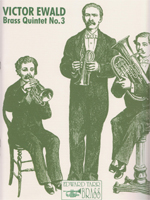Ewald, Victor (Tarr) Quintet No 3 in Db, op 7
Brass Quintets

-
Ewald, Victor (Tarr)
Quintet No 3 in Db, op 7 (Tarr) [211.01]
Romantic. His first known work is a string quartet, Opus 1, which was awarded a third prize in a competition of the St. Petersburg Quartet Society in March, 1893. (The judges were Tchaikovsky, Laroche, and Rimsky-Korsakov, the prize money came from Belaiev.) It was published by Belaiev in 1894. Several other works followed, a Romance, Opus 2, and Deux morceaux, Opus 3, for cello and piano (1894), and a string quintet, Opus 4 (1895). In that year, which was also the year in which he was appointed professor, he apparently ceased composing for a time. Rimsky-Korsakov also reports that by then, the Friday evening quartet sessions had begun to suffer a certain stagnation. In 1899 he did write one piece, the eighth variation (Andante cantabile) of a collective work, Variations sur une theme populaire russe for string quartet, one of the other composers being Scriabin. His next published work, the Brass Quintet No. 1 in B flat Minor, Opus 5, was printed in 1912.1 It was the only one of his three brass quintets to be published during his lifetime. Ewald's Brass Quintets No. 2 in E flat Major, Opus 6, and No. 3 in D flat Major, Op. 7, remained in manuscript and only came to light in the mid-1970s. The original instrumentation of Ewald's three brass quintets is: 2 cornets in B flat, alto horn in E flat, tenor horn in B flat, and tuba. In the present edition, the score is written in concert pitch, and there are several alternatives in the set of parts, to facilitate performance either on the original instruments, the instruments of the modem brass quintet, or whatever. For 211.01 brass quintet (2 trumpets, 1 horn, 1 trombone, 0 euphoniums, 1 tuba). MN30012. Score & parts. -the publisher -
- Category: Brass Quintets
- Item: 109910
- Grade/Level: Advanced
- Price: $58.95
-
(usually ships in 24 hours)
